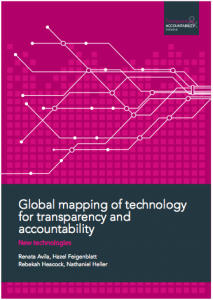The Technology for Transparency Network [1] is proud to announce the release of its final report, Global mapping of technology for transparency and accountability. [2]
The report is being published by the Transparency and Accountability Initiative [3] (@TAInitiative [4]) along with a over a dozen other reports on the global transparency movement. The reports focus on three key research areas: Impact and Learning [5], New Technologies [6], and Policy Innovations [7].
Many thanks go to the Transparency and Accountability Initiative for supporting our work, to our amazing team of researchers [8], and to David Sasaki, who launched and directed [9] the initial phase of the Technology for Transparency Network, which laid the groundwork for this report.
Get the report
Executive Summary
This report contains the key findings from having reviewed more than 100 projects and having interviewed dozens of practitioners in Central and Eastern Europe, East Asia, Latin America, the Middle East and North Africa, South Asia, Southeast Asia, the former Soviet Union, and Sub-Saharan Africa who use new technologies as a means to increase transparency and accountability. This summary helps to ‘take the pulse‘ of the Technology for Transparency and Accountability movement and suggests both exciting possibilities for scaling impact as well as important caveats and challenges.
For practitioners in the transparency and accountability space, it is useful to frame the potential for leveraging technology towards transparency and accountability initiatives in at least four ways:
- Bringing projects and interventions to scale.
- Bringing citizens closer to the policymaking process through new and improved channels of participation as well as citizen monitoring of government.
- Identifying policy priorities and service delivery challenges through ‘data mashing‘ and other visualisation and data manipulation techniques of both government and private datasets.
- Improving the efficiency of civil society organisations working in the transparency and accountability space through adoption of best practice technology platforms.
Additional Findings
The majority of projects we studied focus on the executive [11] or legislative [12] branches of government [13]. A smaller number of projects focus on the judicial branch [14], the media [15], the private sector [16], and donors [17].
Nearly half of the projects focus on monitoring elections [18]. While many of these use Ushahidi [19], some have developed their own approaches, including aggregating elections news from multiple sources on a single site and tracking official election monitors’ reports on Google Maps [20].
Projects in multiple regions focus on transparency in the legislature [12], often tracking legislative bills and posting profiles for each representative that include biographies and voting records. Some also include profiles of political parties or records of legislative spending.
Data visualization and navigation tools are a key feature in more than half of the projects [21] we documented, as are diverse forms of data collection [22] from citizens. Approximately one third of the projects use mobile phones [23] in some way, most commonly by allowing citizens to submit or receive information via text messages.
What's next?
The Technology for Transparency Network website [1] will remain open as a place where we can share projects, tools, and ideas, as a meeting point for successful initiatives and those who want to learn from the work others have done. You can subscribe to our mailing list [24], read or contribute with specialized articles [25] on Global Voices Online, and follow us on Twitter (@techtransparent [26]) and Facebook [27]. This field is just beginning to emerge, and we look forward to helping nurture global efforts through collaboration and communication across borders.
